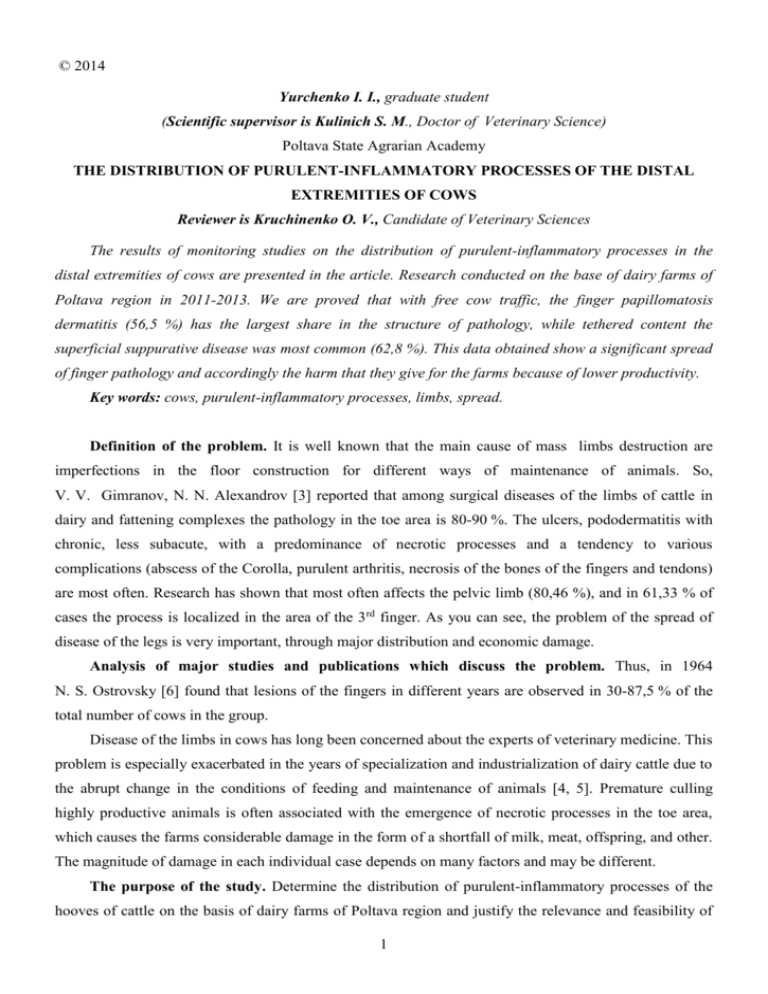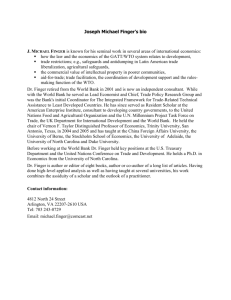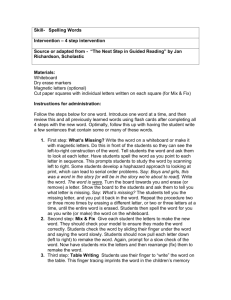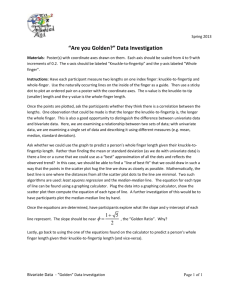УДК 637
advertisement

© 2014 Yurchenko I. I., graduate student (Scientific supervisor is Kulinich S. M., Doctor of Veterinary Science) Poltava State Agrarian Academy THE DISTRIBUTION OF PURULENT-INFLAMMATORY PROCESSES OF THE DISTAL EXTREMITIES OF COWS Reviewer is Kruchinenko O. V., Candidate of Veterinary Sciences The results of monitoring studies on the distribution of purulent-inflammatory processes in the distal extremities of cows are presented in the article. Research conducted on the base of dairy farms of Poltava region in 2011-2013. We are proved that with free cow traffic, the finger papillomatosis dermatitis (56,5 %) has the largest share in the structure of pathology, while tethered content the superficial suppurative disease was most common (62,8 %). This data obtained show a significant spread of finger pathology and accordingly the harm that they give for the farms because of lower productivity. Key words: cows, purulent-inflammatory processes, limbs, spread. Definition of the problem. It is well known that the main cause of mass limbs destruction are imperfections in the floor construction for different ways of maintenance of animals. So, V. V. Gimranov, N. N. Alexandrov [3] reported that among surgical diseases of the limbs of cattle in dairy and fattening complexes the pathology in the toe area is 80-90 %. The ulcers, pododermatitis with chronic, less subacute, with a predominance of necrotic processes and a tendency to various complications (abscess of the Corolla, purulent arthritis, necrosis of the bones of the fingers and tendons) are most often. Research has shown that most often affects the pelvic limb (80,46 %), and in 61,33 % of cases the process is localized in the area of the 3rd finger. As you can see, the problem of the spread of disease of the legs is very important, through major distribution and economic damage. Analysis of major studies and publications which discuss the problem. Thus, in 1964 N. S. Ostrovsky [6] found that lesions of the fingers in different years are observed in 30-87,5 % of the total number of cows in the group. Disease of the limbs in cows has long been concerned about the experts of veterinary medicine. This problem is especially exacerbated in the years of specialization and industrialization of dairy cattle due to the abrupt change in the conditions of feeding and maintenance of animals [4, 5]. Premature culling highly productive animals is often associated with the emergence of necrotic processes in the toe area, which causes the farms considerable damage in the form of a shortfall of milk, meat, offspring, and other. The magnitude of damage in each individual case depends on many factors and may be different. The purpose of the study. Determine the distribution of purulent-inflammatory processes of the hooves of cattle on the basis of dairy farms of Poltava region and justify the relevance and feasibility of 1 further research of these pathologies based on monitoring studies. Study objective: to determine the distribution of various forms of purulent lesions in the distal extremities in cows (2011-2013). Materials and methods. The study was conducted on the basis of two farms Poltava region. During the 2011-2012 performed clinical orthopaedic examination by the method of Borisevich V.B. [2] of the existing 199 cows (black and white breed), owned by LLC "Dukla" (v. Ivashky, Poltava region). During 2013 conducted a similar survey of the existing 850 cows that belong "Astarta-Kyiv", "Gogolevo", MTF #1 (v. Gogolevo) Shishatskiy district, Poltava region. The following diagnoses was consider: superficial suppurative disease, finger laminitis, purulent wounds, purulent arthritis of finger joints, punctures soles (by the B.V. Borisevich) [1], finger papillomatosis dermatitis, heel erosion, ulcer soles (by the K. Burgi) [7]. The available clinical signs of pathology took into account during the survey. The diagnosis was established by comparing with the data which was described in the literature previously. So, purulent pododermatitis of infected animals was accompanied by decreased appetite, animals in motion tried not to rely on the damaged finger. Local signs were noted swelling of the soles; animals have a strong pain and enhanced ripple of finger arteries and the destruction of the horn of the sole during clicked on it. The laminated is the state which was accompanied by deterioration of the general condition of the animal: observed temperature rise, increased heart rate, rapid and shallow breathing, atony. The thoracic limbs were put forward, and pelvic summed up under the belly. Locally support was transferred to a pulp. Limp supporting legs with a noticeable shortening of the step was present. Hooves touch was hot and very sensitive to pressure. When purulent wounds tissues the gap between the fingers cracks observed limp, wound channel and purulent exudate, increased of local temperature, inflammation swelling, throbbing finger arteries. Septic arthritis was noted to increase the temperature to 40 °C, loss of appetite, severe lameness, development paraarticular phlegmon, strong pulsation of finger arteries. For punctures sole registered wound channel, bearing lameness and general oppression. For ulcers sole registered painful defect on the plantar surface - it was discovered during trimming of the hooves. The claudication moderate and increase in local temperature was present. Finger papillomatosis dermatitis was diagnosed in those instances when tight defeat oval (up to 3 cm in width), slightly convex around which grew brown hair bundles found in the field of heels. A pain was well expressed when you click on it. Erosion of the five considered the rear thickening in this area, small bumps and pits, changed the bow to the surface of the heel. The local tenderness and a limp were registered. The results of the research. The results of our research were identified (Table 1) different numbers of sick animals of different types of content. So the most of the affected animals found with free cow 2 traffic (85 animals), and when tethered content was 35 animals. The percentage of the existing number of animals on farms differed significantly. We are found that the most common pathology in the area of the finger on tethered contents were purulent pododermatitis (22 animals). The incidence of the total number of examined cows was 11,1 %, and at loose it was 3 animals (0,3 %). It should be noted that in cows that were loose the most common pathology was finger papillomatosis dermatitis (5,6 %, 48 animals), and tethered content it was two animals (1,0 %). Quite common was laminated with free cow traffic (11 animals, 1,3 %), and for other content it was 3 animals (1,5 %). Table 1. The incidence of purulent lesions plot finger in dairy cows depending on the method of content Method of content and amount of cows fastened Clinical forms not fastened It is discovered defeats: animals Probed total number of livestock %* animals 199 %* 850 Finger papilomatoz dermatitis 2 1,0 48 5,6 Laminit 3 1,5 11 1,3 Superficial festering pododermatitum 22 11,1 3 0,3 Ulcer of sole 1 0,5 5 0,6 Erosion of heel 1 0,5 8 0,9 Running sore - 1 0,1 Festerings arthritises of finger joints 4 2,0 9 1,1 Punctures of sole 2 1,0 - All 35 17,6 85 10 Note: * - the percentage of available livestock animals on farm Purulent arthritis of finger joints with fastened content was recorded in four animals (2.0%), while loose it was 9 animals (1,1 %). Puncture sole registered only when fastened content, it was 2 animals (1,0 %). Ulcer of the sole and heel erosion of digestvalue was registered for fastened content (1 animal, 0,5 %), while loose it was 5 animals (0,6 %) and 8 animals (0,9 %) respectively. Purulent wound was registered for one cow only (0,1 %) with free cow traffic. Research was conducted in the context of farms also. 3 The treat pododermatitis had 62,8 % in the structure of pathology in cows’ dairy farm of v. Ivashky (Table 2). Finger papillomatosis dermatitis and puncture of the sole was 5,7 %, laminitis was 8,6 % (three cases). Four animals has diagnosed with suppurative arthritis of finger joints (11,4 %). An ulceration of the sole and heel erosion has the lowest percentage (2,9 %). Table 2. The distribution of pathology in the area of fingers among the cows of dairy farm of v. Ivashky Sick animals Types of pathologies Animals % Festering pododermatitis 22 62,8 Finger papillomatosis dermatitis 2 5,7 Laminit 3 8,6 Festerings arthritises of finger joints 4 11,4 Punctures of sole 2 5,7 Ulcer of sole 1 2,9 Erosion of heel 1 2,9 All 35 100 The highest percentage in the structure of pathology (56,5 %) accounted for the finger papillomatosis dermatitis (Table 3). 11 cows (12,9 %) of farm were sick by laminitis. 9 animals have purulent arthritis of finger joints (10,6 % of the amount of pathology in the toe area). 8 cows’ farms have erosion of the heel (9,4 %). Ulcer soles has 5,9 % of animals. Festering pododermatitis has three animals (3,5 % from patterns of pathology). Purulent wounds have the smallest proportion (1,2 %). Table 3. The distribution of lesions of the extremities of necrotic nature of the dairy cows MTF #1, VP "Gogolevo" Sick animals Animals Types of pathologies % Finger papillomatosis dermatitis 48 56,5 Festering pododermatitis 3 3,5 Laminit 11 12,9 Festerings arthritises of finger joints 9 10,6 Running sore 1 1,2 Ulcer of sole 5 5,9 4 Erosion of heel 8 9,4 All 85 100 Conclusion. So the most common pathology in the structure of the distal with nonfastened content was finger papillomatosis dermatitis (56,5 %), while tethered content it was superficial suppurative disease (62,8 %). Our conclusion based on the monitoring data on the cows pathology finger distribution on dairy farms of the Poltava region. BIBLIOGRAPHY 1. Борисевич Б. В. Ветеринарна ортопедія: хвороби копит і копитець. Навчальний посібник / [В. Б. Борисевич, Б. В. Борисевич, О. Ф. Петренко та ін.]. – К. : ДІА, 2007. – 136 с. 2. Борисевич В. Б. Ортопедія парно- і непарнопалих тварин. Навчальний посібник / [В. Б. Борисевич, Б. В. Борисевич, В. П. Сухонос та ін.]. – К : НАУ, 2008. – 183 с. 3. Гимранов В. В. Клинико-морфологическая характеристика гнойно-некротических процессов области пальцев у крупного рогатого скота [сб. науч. трудов] / В. В. Гимранов, Н. Н. Александров // Болезни конечностей сельскохозяйственных животных. – М. : Моск. вет. акад., 1988. – С. 54. 4. Захаров В. И. Распространение хирургических заболеваний у коров при беспривязнобоксовом содержании на щелевых полах / В. И. Захаров [cб. «Профилактика незаразных болезней сельскохозяйственных животных»]. – М, 1977. – С. 186–192. 5. Никаноров П. Н. Травматизм конечностей у коров при беспривязном боксовом содержании на щелевых полах промышленных комплексов и его профилактика / П. Н. Никаноров, И. М. Касьянов, К. Б. Шевченко. – 1976. – С. 11–13. (Труды науч.-тех. института экспериментальной ветеринарии Сибири и Дальнего Востока ; вып. 8). 6. Островский Н. С. Гнойно-некротические заболевания пальцев крупного рогатого скота : автореф. дис. на соиск. уч. степ. д-ра вет. наук : спец. 16.00.05 «Ветеринарная хирургия» / Н. С. Островский. – Новочеркасск, 1964. – 27 с. 7. http://rpp.nashaucheba.ru/docs/index-118617.html 5









